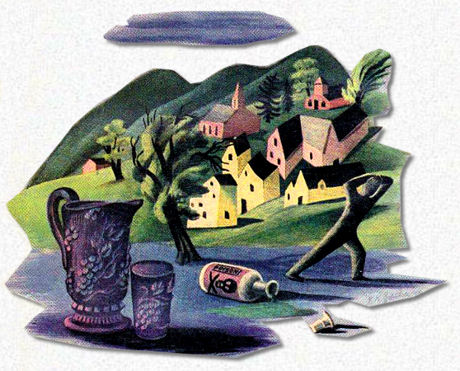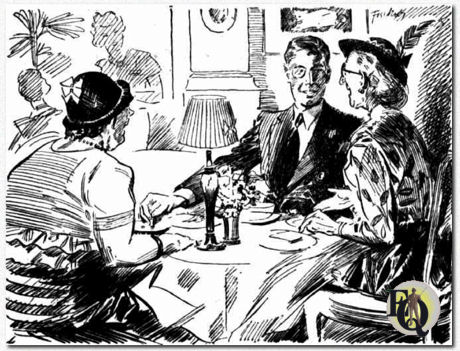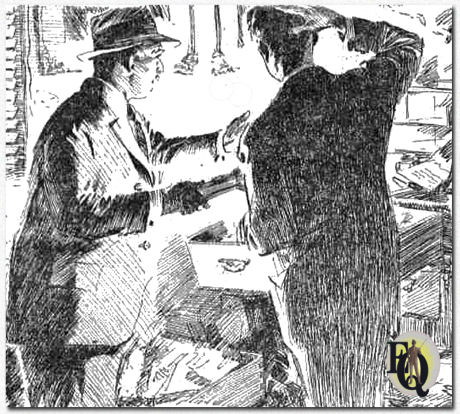
 |
![]()
WRIGHTSVILLE
 |
|
Wrightsville, where many of Ellery Queen's novel-length and short-story adventures take place over the next three decades. Wrightsville was a place where people lived, worked, and died in an atmosphere of decency and independence. A typical American town, nestled in the great American heartland, up to its collective neck in good old American corn. One could freely breathe the air here, although the industry has had its influence. As to its origin... on the criminous level, the central influence seems to have been Alfred Hitchcock's 1941 film Suspicion. Of course, Wrightsville's milieu, people, plot, details, overall framework, and everything else about it are fully organic to Queen's own vision, not yanked bodily from any prior source but shaped in part by earlier work just as everything we say and do is shaped at least in part by what others have said and done before us. And so Wrightsville seems to be influential on later work in the mystery genre and especially on another extraordinary film by Alfred Hitchcock Shadow of a Doubt (1943) Its primary scenarist was Thornton Wilder. His famous play Our Town (1938) surely influenced  Wrightsville but in
the movie, although some resemblance to Grover's Corners in Our Town is
a fact even more this is the case with Queen's Wrightsville. The girl Charlie
(played by Teresa Wright) is a near-perfect cinematic image of Pat
Wright even to the point that both their fathers were bankers... Wrightsville but in
the movie, although some resemblance to Grover's Corners in Our Town is
a fact even more this is the case with Queen's Wrightsville. The girl Charlie
(played by Teresa Wright) is a near-perfect cinematic image of Pat
Wright even to the point that both their fathers were bankers... We even dare to add that the name Wrightsville could easily refer to their early idol S.S. Van Dine whose real name was Willard Huntington Wright! Richard and Douglas Dannay have since stated that it was poetry which inspired Wrightsville: Spoon River Anthology (Tragedy of Errors, 1999). This is a book by Edgar Lee Masters from 1914 - 1915 which consists of a collection of poems/epitaphs. In it the dead on "the cemetery on the hill" relay details from their lives. The fictional town of "Spoon River" was named after the river which ran near his hometown. This innovative approach was interwoven with childhood memories Masters' had of former residents of Lewistown and Petersburg, Illinois. |
| "Of course what made
Spoon River Anthology immediately popular was the shock of
recognition. Here for the first time in America was the whole
of a society which people recognized - not only that part of it reflected in
writers of the genteel tradition. Like
Chaucer's pilgrims, the 244 characters who speak their epitaphs represent
almost every walk of life--from Daisy Frazer, the town prostitute, to
Hortense Robbins, who had travelled everywhere, rented a house in Paris and
entertained nobility; or from Chase Henry, the town drunkard, to Perry Zoll,
the prominent scientist, or William R Herndon, the law partner of Abraham
Lincoln. The variety is far too great for even a partial list. There are
scoundrels, lechers, idealists, scientists, politicians, village doctors,
atheists and believers, frustrated women and fulfilled women. The
individual epitaphs take on added meaning because of often complex
interrelationships among the characters. Spoon River is a community, a
microcosm, not a collection of individuals." (Ernest Earnest, Spoon River Revisited, 1967) |
| Being the writing duo they were, it was only a matter
of time before Manfred influence in the Wrightsville saga was unearthed.
Patricia Lee Caldwell recalls:
"Uncle Hy Miller attended college at New York University and there met Manny
Lee. Uncle Hy had a great singing voice and may also have played some
instrument and some time later they formed a band with three or four other
students and performed in various venues, including on some cruises and at
some vacation spots". This was the five piece jazz-band Manny directed
for a while (he was an excellent violin player). At some point in 1926
Hy brought his friend and fellow band member Manny Lee to Philadelphia for a
weekend to meet the family. That weekend, Manny Lee met Claremont-born Betty
Miller. One year later the couple was married
(1927 - 1928).
When the Queen cousins decided to place sleuth Ellery into a small-town setting in New England, they created Wrightsville, which incorporates many features of Claremont. “I remember clearly that my mother told me that Wrightsville was based on Claremont,” said Patricia Lee Caldwell. In fact, the old Claremont Eagle newspaper provided front-page coverage (on Jul 10. 1959) of a talk Manny Lee gave in Claremont, in which he revealed that the Wrightsville setting for several Queen books was indeed based on Claremont. The state’s Union-Leader newspaper covered that talk too. The first three Wrightsville novels are first-rate mysteries and far superior to the others, but Double, Double offers a special treat to Claremonters. Its original end papers are decorated with a map of Wrightsville, which looks remarkably like Claremont. |
 Above: Map of Wrightsville as included on the inside cover of Double, Double (1950, Little & Brown) |
|
Both towns have a round Square with five streets hooked up to it, like
spokes from a wheel. (Claremont has Main, Sullivan, Pleasant, Broad, and
Tremont; Wrightsville has Washington, Lincoln, Upper Dade, State, and Lower
Main.) Both towns have a bandstand right off the Square. References to High
Village and Low Village in Wrightsville have a foundation in Claremont. The
Hollis Hotel in Wrightsville could easily be The Hotel Moody in Claremont.
Wrightsville and Claremont each has a small airport. Wrightsville and
Claremont share a similar size. Even the distance from Claremont’s Amtrak
station into town matches the distance for a corresponding train in
Wrightsville. Plus, certain circumstances about Wrightsville — such as the railroad’s coming all the way into town for an additional stop, and the daily newspaper’s offices being located on the Square —were true in Claremont’s mid-20th century days though not today. Most of J.J. McC’s forewords bore the dateline New York. However, the foreword in The Siamese Twin Mystery (1933) bears this dateline: “Claremont, N.H.” (Claremont info thanks to Arthur Vidro) |

|
Above: Claremont, NH, has a Square which was round... with five streets hooked up to it. Bandstand and statue included... |
|
At least it is clear that the area East of New York plays a special part in Ellery Queen's life. The creators lived there for most of their life and many of there stories are situated in that area. No wonder that in The Finishing Stroke their main figures traveled through this region... |
|
once called the Green and the river 'Willow'. On the town's Square (which was actually round) one could found Jezreel Monument. Great-great-great-great-something of John F. Wright (banker) had founded Wrightsville in 1702. The thoroughfares which radiated like spokes from the hub of the square. One spoke was a was a broad avenue: the Wrightsville National Bank (on the Northern Arc of the square), the red-brick Town Hall were State Street began, Carnegie Library and beyond WPA-looking buildings. Another spoke was Lower Main: stores, the Wrightsville Record offices, a Five-and-Dime, the "new" Post Office buildings, "Bijou Theater", J.C. Pettigrew's real estate office and Al Brown's Ice Cream Parlor. |
|
Wrightsville was populated with easy recognizable characters:
|
 Above: Miss Aikin, librarian over at the Carnegie Library on State Street, in Miss Sally's Tea Roome (near Miss Dupre home down the Hill) and Miss Emmeline DuPre have Ellery's full attention. (2) |
|
How about law and justice in Wrightsville?
|
 Above: Ellery and Chief Dakin who is yielding the beam of his torch like a broom. (2) |
|
 |
|
"The
Wrightsville Murders" are: 1 Calamity Town 1942 2 The Murderer Is a Fox 1945 3 Ten Days' Wonder 1948 4 Double, Double 1950 5 The King is Dead 1952 (one chapter) 6 "The Robber of Wrightsville" 1953 (short story in Today's Family 2/53 and as "The Accused" in EQMM 12/54) 7 "GI Story" 1954 (short story in EQMM 8/54) 8 "Eve of the Wedding" 1955 (short story, as "Bride in Danger" in EQMM 8/55) 9 "The Wrightsville Heirs" 1956 (novelette, Better Living 1/56 reprinted in EQMM 11/57) 10 "The Death of Don Juan" 1962 (novelette, Argosy 5/62 reprinted in EQMM 8/64) 11 "Mum is the Word" 1966 (novelette, EQMM 4/66) 12 "Wedding Anniversary" 1967 (short story, EQMM 9/67) 13 The Last Woman in His Life 1970 |
|
For more on the influences on the
Wrightsville stories click
here ... West 87th Street Irregular Nathanael T. Booth |
|
|

|
| Introduction | Floor Plan | Q.B.I. |
List of Suspects | Whodunit? | Q.E.D. | Kill as directed | New | Copyright Copyright © MCMXCIX-MMXXV Ellery Queen, a website on deduction. All rights reserved. |